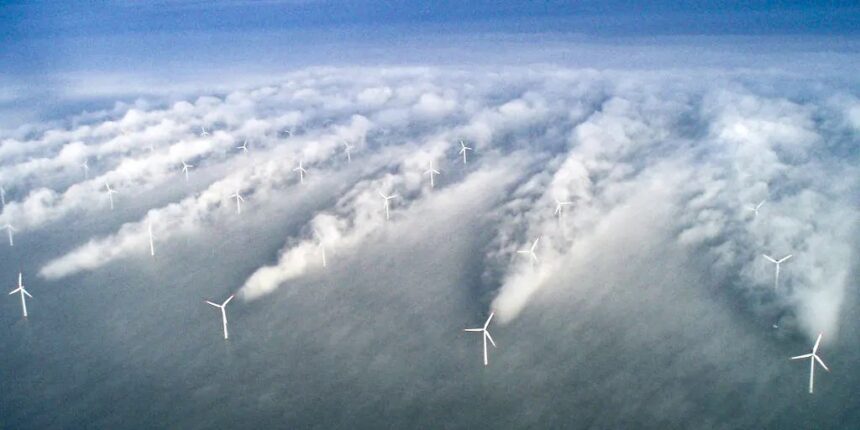of Teacherresource
By Robert Bradley Jr.
The media bias favoring industrial wind turbines can be seen. Simple reporting of the facts, from costs to environmental compensation, can inform the public and voters to get rid of the government gravy train that harms almost all of us. That is, everyone except wind developers and other constituencies in the Climate Industrial Complex.
It is not common to see a break in the narrative of “energy transition.” This was recently over at E&E News’s Energywire, “‘Wake effect’ could drain 38% of offshore wind power, study says”. This piece by Heather Richards (May 5, 2024) deserves further investigation. Key quotes below:
Findings from national labs and university researchers add to assumptions about how turbines interact.
Wind turbines off the East Coast may be depleting energy from each other, reducing the power output of offshore farms by 38 percent, according to a new study that challenges early assumptions about the industry’s new electricity contribution.
The findings add to research on the “wake effect,” which is when offshore turbines in close proximity affect each other’s energy output.
Researchers from the University of Colorado and the National Renewable Energy Laboratory (NREL) found that entire wind farms can block neighboring projects, reducing the power production of adjacent farms by up to 15 percent in some conditions.
———————
In a research paper, “New offshore wind turbines can remove energy from existing ones,” Science Direct reported on the findings, with the authors offering an apologetic (“We need a mix of clean energy sources to meet demand and decarbonize the grid. “) and ( “With better predictability of wind energy, we can rely more on renewable energy”). The article states:
In a new paper published March 14 in the journal Wind Energy Science, a team led by Dave Rosencrans, a doctoral student, and Julie K. Lundquist, a professor in the Department of Atmospheric and Oceanic Sciences, estimated that offshore wind turbines in the Atlantic Ocean region, where the US plans to build a large wind farm, could eliminate the wind from other turbines in the vicinity, can reduce farm power output by more than 30%.
Accounting for the so-called “wake effect”, the team estimates that the proposed wind farm could still supply about 60% of the electricity demand in the New England grid, which includes Connecticut, Maine, Massachusetts, New Hampshire, Rhode Island, and Vermont.
“The US is planning to build thousands of offshore wind turbines, so we have to predict when the wakes will be expensive and when they will have little effect,” said Lundquist, who is also a fellow at CU Boulder’s updated and Sustainable Energy Institute.
As the wind passes through the turbine, the one in front, or upstream, captures some of the energy from the wind. As a result, the wind slows down and becomes more turbulent behind the turbine. This means that downstream turbines get wind more slowly, sometimes resulting in lower power generation.
The wake effect is mainly offshore, because there are no houses or trees to disturb the air, which helps to eliminate the wakes, said Rosencrans, the first author of the paper.
Using computer simulations and atmospheric observation data, the team calculated that the wake effect would reduce the total power generation by 34% to 38% at the proposed East Coast wind farm. Most of the reduction comes from the wakes that form between the turbines on a farm.
But in certain weather conditions, wakes can reach turbines up to 55 kilometers downwind and affect other wind farms. For example, in summer, air flow over the cold sea surface tends to stabilize, causing wakes to persist for longer periods and spread over longer distances.
There is another problem for offshore wind….
“Unfortunately, summer is when there’s a lot of demand for electricity,” Rosencrans said. “We showed that wakes will have a significant impact on power generation. But if we can predict the effect and anticipate when it will happen, then we can manage it in the power grid.
Compared to energy sources derived from fossil fuels, wind and solar power tend to differ, as the sun does not always shine and the wind does not always blow. This variability creates challenges for grid operators, said Lundquist. Power grids are complex systems that require a perfect balance of supply and demand in real time. Any imbalance can lead to blackouts, as happened in Texas in 2021 when a power outage killed nearly 250 people.
To better understand how the wind is blowing in the proposed wind farm area, Lundquist’s team visited an island off the coast of New England and installed several instruments last December as part of the Department of Energy’s Wind Forecast Improvement Project 3. The project is a collaboration of researchers from CU Boulder, Woods Hole Oceanographic Institute and several other national laboratories.
The instruments, including weather monitors and radar sensors, will collect data for the next year or so. Previously, offshore wind power prediction models mostly relied on intermittent data from ships and satellite observations. The hope is that with continuous data directly from the ocean, scientists can improve their prediction models and better integrate offshore wind energy into the grid.
Or not. Wind is an imperfect energy for grids, and other offshore wind.
Related




